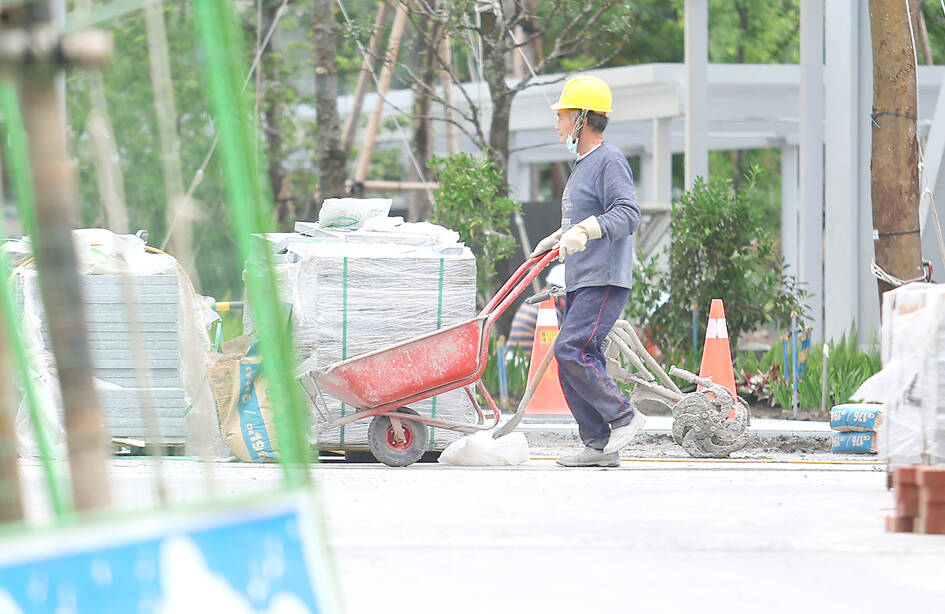The unemployment rate fell 0.13 percentage points from August to 3.66 percent last month, the Directorate-General of Budget, Accounting and Statistics said yesterday.
Last month’s figure was also 0.3 percentage points lower than the level in September last year and the lowest in five months, the agency said in its monthly report.
The unemployment rate after seasonal adjustments fell 0.03 percentage points from August to 3.64 percent, the report said.

Photo: CNA
The result is in line with the statistics agency’s expectations, following the peak period for university graduates to enter the job market, which often falls between June and August.
The number of unemployed people last month fell by 16,000 from a month earlier to 433,000, with the number of first-time jobseekers failing to land positions decreasing by 9,000 monthly and those who lost their jobs due to business downsizing and closures dropping by 5,000, the report said.
The number of people who worked fewer than 35 hours a week was 213,000 last month, down from 279,000 in August and 295,000 in September last year, the agency said.
The DGBAS said the local labor market has returned to pre-COVID-19 pandemic levels, given the declines in both the unemployment rate and the number of people who were unemployed.
The improvement in the labor market was also reflected in youth unemployment figures. The unemployment rate among people aged 20 to 24 fell to 12.7 percent from 13.06 percent in August. The rate for the 25-to-29 age bracket dropped to 6.01 percent from 6.18 percent, while the rate for the 15-to-24 age group was 8.95 percent last month, little changed from 8.9 percent in the previous month, the data showed.
The unemployment rate for people aged 30 to 34 fell to 3.87 percent from 3.89 percent in August, the report said.
By education breakdown, people with university education had the highest unemployment rate with 5.29 percent, followed by high-school graduates with 3.26 percent and graduate degree holders with 2.8 percent, the data showed.
The average unemployment period last month rose by seven days to 22 weeks, as it took first-time jobseekers 20.8 weeks to land positions, while others spent 22.3 weeks finding jobs, the report said.
The number of people who had been unemployed for more than a year last month fell by 2,000 from August to 62,000, but rose by 18,000 from a year earlier, it said.
In the first nine months of this year, the unemployment rate was 3.69 percent, down 0.35 percentage points from a year earlier, the agency said.
Looking ahead, the jobless rate would likely fall further this month thanks to the recovery in the service sector, it added.

Hong Kong authorities ramped up sales of the local dollar as the greenback’s slide threatened the foreign-exchange peg. The Hong Kong Monetary Authority (HKMA) sold a record HK$60.5 billion (US$7.8 billion) of the city’s currency, according to an alert sent on its Bloomberg page yesterday in Asia, after it tested the upper end of its trading band. That added to the HK$56.1 billion of sales versus the greenback since Friday. The rapid intervention signals efforts from the city’s authorities to limit the local currency’s moves within its HK$7.75 to HK$7.85 per US dollar trading band. Heavy sales of the local dollar by

Taiwan Semiconductor Manufacturing Co’s (TSMC, 台積電) revenue jumped 48 percent last month, underscoring how electronics firms scrambled to acquire essential components before global tariffs took effect. The main chipmaker for Apple Inc and Nvidia Corp reported monthly sales of NT$349.6 billion (US$11.6 billion). That compares with the average analysts’ estimate for a 38 percent rise in second-quarter revenue. US President Donald Trump’s trade war is prompting economists to retool GDP forecasts worldwide, casting doubt over the outlook for everything from iPhone demand to computing and datacenter construction. However, TSMC — a barometer for global tech spending given its central role in the

The Financial Supervisory Commission (FSC) yesterday met with some of the nation’s largest insurance companies as a skyrocketing New Taiwan dollar piles pressure on their hundreds of billions of dollars in US bond investments. The commission has asked some life insurance firms, among the biggest Asian holders of US debt, to discuss how the rapidly strengthening NT dollar has impacted their operations, people familiar with the matter said. The meeting took place as the NT dollar jumped as much as 5 percent yesterday, its biggest intraday gain in more than three decades. The local currency surged as exporters rushed to

PRESSURE EXPECTED: The appreciation of the NT dollar reflected expectations that Washington would press Taiwan to boost its currency against the US dollar, dealers said Taiwan’s export-oriented semiconductor and auto part manufacturers are expecting their margins to be affected by large foreign exchange losses as the New Taiwan dollar continued to appreciate sharply against the US dollar yesterday. Among major semiconductor manufacturers, ASE Technology Holding Co (日月光), the world’s largest integrated circuit (IC) packaging and testing services provider, said that whenever the NT dollar rises NT$1 against the greenback, its gross margin is cut by about 1.5 percent. The NT dollar traded as strong as NT$29.59 per US dollar before trimming gains to close NT$0.919, or 2.96 percent, higher at NT$30.145 yesterday in Taipei trading